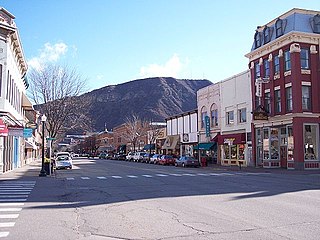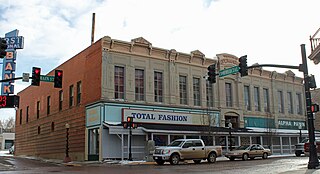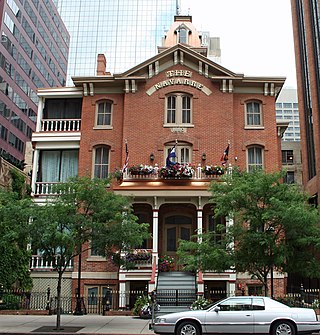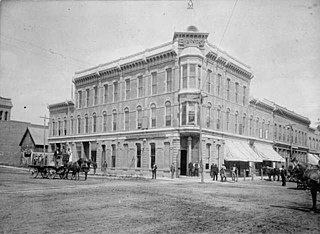The National Register of Historic Places (NRHP) is the United States federal government's official list of districts, sites, buildings, structures, and objects deemed worthy of preservation for their historical significance or "great artistic value". A property listed in the National Register, or located within a National Register Historic District, may qualify for tax incentives derived from the total value of expenses incurred in preserving the property.

The Inns on the National Road is a national historic district near Cumberland, Allegany County, Maryland. It originally consisted of 11 Maryland inns on the National Road and located in Allegany and Garrett counties. Those that remain stand as the physical remains of the almost-legendary hospitality offered on this well-traveled route to the west.

Main Avenue Historic District in Durango, Colorado is a 34-acre (14 ha) historic district that was listed on the National Register of Historic Places in 1980.
The Trinchera Cave Archeological District (5LA9555) is an archaeological site in Las Animas County, Colorado with artifacts primarily dating from 1000 BC to AD 1749, although there were some Archaic period artifacts found. The site was added to the National Register of Historic Places in 2001 and is located on State Trust Lands.

The Helena Historic District (HHD) is a federally designated historic district in Helena, Montana, United States. Since its establishment in 1972, the HHD has had boundary adjustments in 1990 and 1993. The original 1972 designation was composed of two unconnected sections known as "Downtown" and "West Residential".

The Exchange Place Historic District in Downtown Salt Lake City, Utah, United States is a historic district that was listed on the National Register of Historic Places in 1978. It included ten contributing buildings and three non-contributing buildings on a 6.2-acre (2.5 ha) area, with significance dating to 1903.

The Bent County Courthouse and Jail, of Bent County, Colorado, at 725 Carson Ave. in Las Animas, was built in 1887. It was listed on the National Register of Historic Places in 1976; the listing included two contributing buildings.

The Tempe Wick Road–Washington Corners Historic District is a 353-acre (143 ha) historic district located in Harding Township and Mendham Township in Morris County, New Jersey. It extends along Tempe Wick Road from Mount Kemble Avenue to Cold Hill Road, and short segments of Corey Lane, Cemetery Road, Kennaday Road, Leddell Road, and Jockey Hollow Road. Tempe Wick Road is named for Temperance Wick. The district was added to the National Register of Historic Places on August 25, 2000, for its significance in architecture and military history. The district includes 44 contributing buildings, 6 contributing sites, 10 contributing structures, and 4 contributing objects.

The John Smith House is a historic building located at 124 Washington Valley Road in the Washington Valley section of Morris Township, Morris County, New Jersey. The two-story brick house was built in 1812, with the year set in black brick on the west gable. It was added to the National Register of Historic Places on January 1, 1976, for its significance in agriculture and architecture. It is also a contributing property of the Washington Valley Historic District.
Nisbet & Paradice was an architectural firm in Idaho. It was a partnership of architects Benjamin Morgan Nisbet and Frank H. Paradice, Jr. formed in 1909. The partnership lasted five years. They dissolved it in 1915, and Nisbet moved to Twin Falls, Idaho to establish an individual practice, and Paradice did likewise in Pocatello, Idaho. A number of their works are recognized by listings on the National Register of Historic Places (NRHP).

The Combs Hollow Historic District is a historic district in Randolph, Morris County, New Jersey and extending into Mendham Township. The district was added to the National Register of Historic Places on February 16, 1996, for its significance in industry from c. 1735 to 1927. It includes 11 contributing buildings, 4 contributing structures, and 14 contributing sites.

The Jaffa Opera House, at 100–116 W. Main St. in Trinidad, Colorado, was built in 1883. It was listed on the National Register of Historic Places in 1972.

The Brinker Collegiate Institute is a historic school building in Denver, Colorado, United States, that is listed on the National Register of Historic Places (NRHP).

The Downtown Loveland Historic District in Loveland, Colorado is an 18 acres (7.3 ha) historic district which was listed on the National Register of Historic Places in 2015. It includes Loveland's commercial center which began in 1877, developed first as a railroad town, and then became an agricultural center and a regional center of government and commerce.

The Downtown Boulder Historic District, in Boulder, Colorado, is a 48 acres (19 ha) historic district which was listed on the National Register of Historic Places in 1980. Additional significance for the district was recognized in 2018 for association of the Boulder County Courthouse with events of 1975, when Boulder County clerk Clela Rorex issued marriage licenses to six same-sex couples.
George Louis Bettcher (1862–1952) was an American architect based in Denver, Colorado. He designed a number of buildings which survive and are listed on the National Register of Historic Places for their architecture.

Old Town Fort Collins, in Fort Collins, Colorado, is a historic district which was listed on the National Register of Historic Places in 1978. By roughly the same official name, "Old Town Historic District", it is also the name of an overlapping, larger, local landmark historic district designated in 1972, and "Old Town" is informally a term for a much larger area.

The Morristown District, also known as the Morristown Historic District, is a historic district in the town of Morristown in Morris County, New Jersey. It was added to the National Register of Historic Places on October 30, 1973, for its significance in architecture, communications, education, military, politics, religion, social history, and transportation. The initial district listing had 50 contributing buildings, including the Thomas Nast Home and the Dr. Lewis Condict House, which were previously listed individually on the NRHP, and the Morristown Green. The district boundary was increased from 93 acres (38 ha) to 213 acres (86 ha) as part of the Morristown Multiple Resource Area (MRA) in 1986 and now has 352 contributing buildings, including the Morristown station and the Morris County Courthouse, which were previously listed individually.















